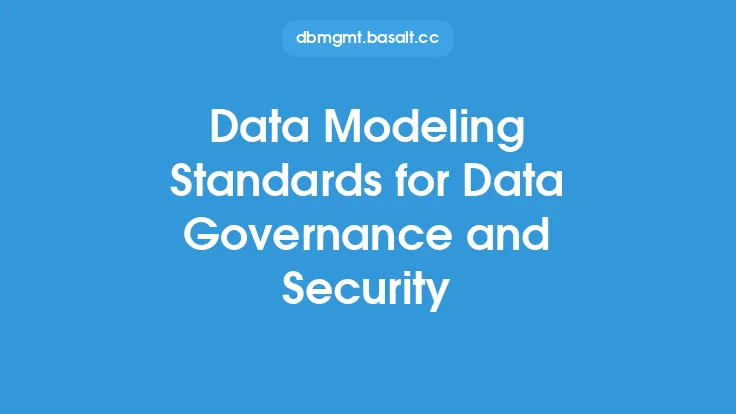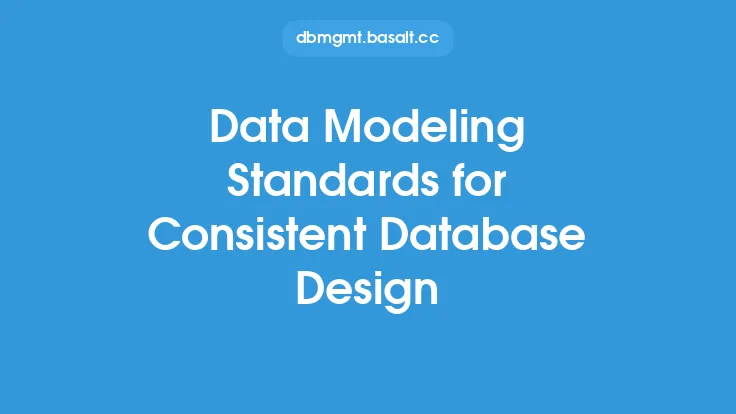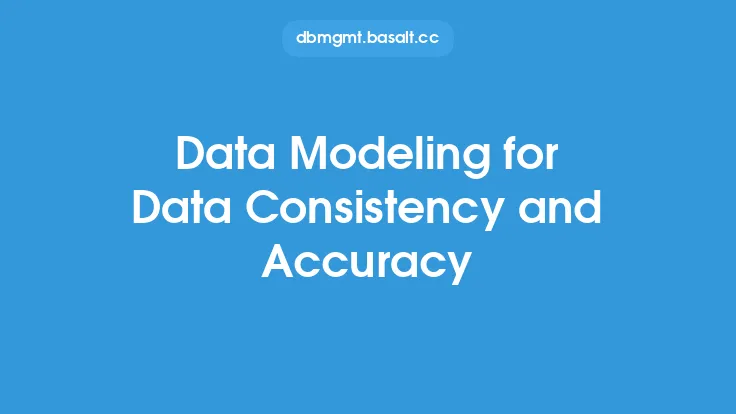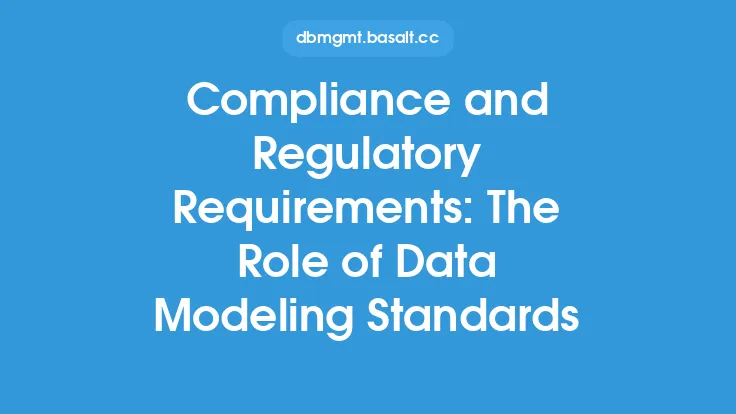Data modeling is a crucial aspect of data management, and establishing standards for data modeling is essential to ensure data quality and integrity. Data modeling standards provide a framework for creating, managing, and maintaining high-quality data models that accurately represent the organization's data assets. These standards help to ensure that data models are consistent, complete, and unambiguous, which is critical for making informed business decisions.
Introduction to Data Modeling Standards
Data modeling standards are a set of guidelines, rules, and best practices that govern the creation, development, and maintenance of data models. These standards are designed to ensure that data models are of high quality, consistent, and aligned with the organization's overall data management strategy. Data modeling standards cover various aspects of data modeling, including data structure, data types, data relationships, and data integrity. By establishing and adhering to data modeling standards, organizations can ensure that their data models are accurate, reliable, and scalable.
Key Components of Data Modeling Standards
Data modeling standards typically consist of several key components, including:
- Data structure standards: These standards define the rules for creating and organizing data structures, such as tables, entities, and relationships.
- Data type standards: These standards define the rules for assigning data types to attributes, such as integer, string, and date.
- Data relationship standards: These standards define the rules for creating and managing relationships between data entities, such as one-to-one, one-to-many, and many-to-many.
- Data integrity standards: These standards define the rules for ensuring data consistency and accuracy, such as primary keys, foreign keys, and check constraints.
- Naming conventions: These standards define the rules for naming data entities, attributes, and relationships, such as using descriptive names and avoiding abbreviations.
Benefits of Data Modeling Standards
Establishing and adhering to data modeling standards offers several benefits, including:
- Improved data quality: Data modeling standards help to ensure that data models are accurate, complete, and consistent, which is critical for making informed business decisions.
- Increased data integrity: Data modeling standards help to ensure that data is consistent and accurate, which reduces the risk of data errors and inconsistencies.
- Enhanced data sharing and collaboration: Data modeling standards provide a common language and framework for data sharing and collaboration, which facilitates communication and coordination among stakeholders.
- Better data governance: Data modeling standards provide a framework for managing and maintaining data assets, which helps to ensure that data is properly governed and secured.
- Improved data-driven decision making: Data modeling standards help to ensure that data models are accurate and reliable, which enables organizations to make informed business decisions.
Best Practices for Implementing Data Modeling Standards
Implementing data modeling standards requires a structured approach and a commitment to ongoing maintenance and improvement. Some best practices for implementing data modeling standards include:
- Establishing a data modeling team: This team should be responsible for developing, maintaining, and enforcing data modeling standards.
- Developing a data modeling framework: This framework should provide a structured approach to data modeling, including guidelines, templates, and tools.
- Providing training and education: This training should be provided to data modelers, developers, and other stakeholders to ensure that they understand and can apply data modeling standards.
- Conducting regular reviews and audits: These reviews and audits should be conducted to ensure that data models are compliant with data modeling standards and to identify areas for improvement.
- Continuously monitoring and improving: Data modeling standards should be continuously monitored and improved to ensure that they remain relevant and effective.
Tools and Techniques for Data Modeling Standards
Several tools and techniques are available to support the implementation and maintenance of data modeling standards, including:
- Data modeling software: This software provides a range of tools and features for creating, managing, and maintaining data models, such as entity-relationship diagrams, data flow diagrams, and data dictionaries.
- Data governance platforms: These platforms provide a range of tools and features for managing and governing data assets, such as data catalogs, data quality metrics, and data lineage.
- Data quality tools: These tools provide a range of features for ensuring data quality, such as data validation, data cleansing, and data normalization.
- Metadata management tools: These tools provide a range of features for managing and maintaining metadata, such as data dictionaries, data catalogs, and data lineage.
Challenges and Limitations of Data Modeling Standards
While data modeling standards offer several benefits, there are also challenges and limitations to consider, including:
- Resistance to change: Implementing data modeling standards may require significant changes to existing data models, processes, and culture, which can be challenging to implement and maintain.
- Complexity: Data modeling standards can be complex and require significant expertise and resources to develop and maintain.
- Cost: Implementing and maintaining data modeling standards can require significant investment in tools, training, and resources.
- Balancing standardization and flexibility: Data modeling standards must balance the need for standardization with the need for flexibility and adaptability to changing business requirements.
Conclusion
Data modeling standards are essential for ensuring data quality and integrity, and for supporting data-driven decision making. By establishing and adhering to data modeling standards, organizations can ensure that their data models are accurate, reliable, and scalable. While there are challenges and limitations to consider, the benefits of data modeling standards far outweigh the costs. By following best practices, using the right tools and techniques, and continuously monitoring and improving, organizations can establish and maintain effective data modeling standards that support their overall data management strategy.





